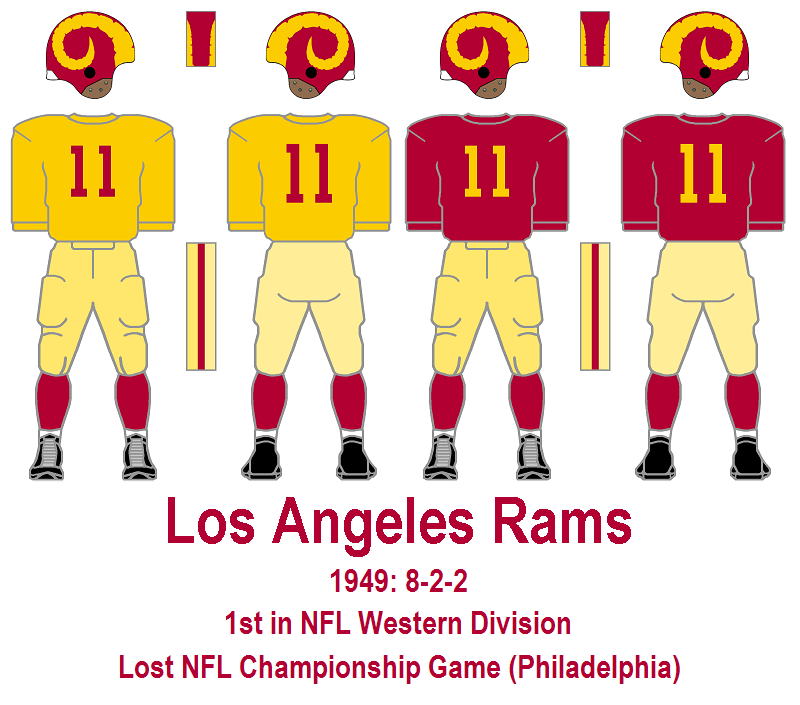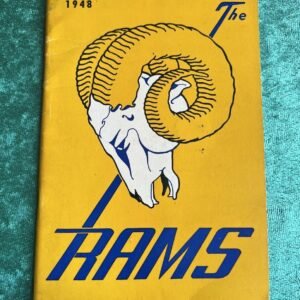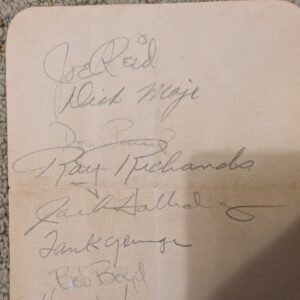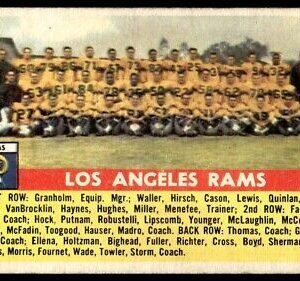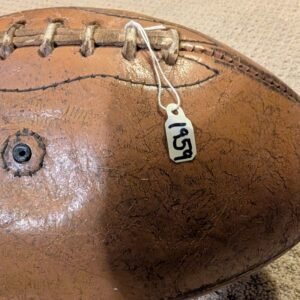Description
The 1949 Los Angeles Rams season was a significant one in the history of the franchise. While the team showed promise with a solid regular-season record, the 1949 season was notable for a few reasons, particularly with the changing dynamics of the NFL as it continued to grow in popularity. Here’s a breakdown of the 1949 Los Angeles Rams:
Key Points about the 1949 Los Angeles Rams:
-
Record:
- The 1949 Los Angeles Rams finished the season with a 8-4 record, marking another strong year for the team. However, despite their solid performance, they finished in 2nd place in the NFL Western Division, behind the Chicago Bears, who again dominated the division.
- Once again, the Rams were competitive but didn’t have enough to secure a playoff berth or challenge for the division title, primarily due to the Bears’ dominance.
-
Coaching:
- Joe Stydahar, who had been hired as the Rams’ head coach in 1947, was still at the helm in 1949. Under Stydahar’s leadership, the Rams showed improvement in several areas, especially on offense. However, they still couldn’t break through to the league’s elite level, largely due to their struggles against the top-tier teams like the Bears.
- Stydahar’s tenure marked a shift toward better overall performance and a growing emphasis on team-building for the future.
-
Key Players:
- Bob Waterfield (quarterback) was again a key player for the Rams, continuing his leadership on offense. His passing was critical to the team’s success, though he was starting to deal with some injuries as his career progressed.
- Tom Fears, the star wide receiver, had another excellent season. Fears had been one of the top wide receivers in the league for several years, and his contributions were essential to the Rams’ offensive attack.
- Elroy “Crazylegs” Hirsch, a standout wide receiver and one of the NFL’s most dangerous deep threats, continued to be an offensive weapon. His combination of speed and athleticism made him a constant threat on the field.
- Ace Parker continued to provide leadership and offensive skill, although by this point, he was not the primary star he had been in earlier years.
-
Offense:
- The Rams had a potent offense in 1949, with a passing attack led by Bob Waterfield, and strong performances from Tom Fears and Elroy Hirsch. The Rams’ passing game was one of the top in the league, and Waterfield was able to connect with his receivers for big plays.
- The Rams’ offense ranked highly in terms of total yards and points scored. However, the team was still sometimes inconsistent, and the Chicago Bears‘ superior defense and balance were a major challenge in the Western Division.
-
Defense:
- The Rams’ defense was decent but not as strong as their offense. Their defensive unit struggled to match up against the league’s most powerful teams. While they were not terrible, they couldn’t generate the same kind of pressure or impact plays that other top teams, like the Bears, could create.
- One of the key areas of improvement for the Rams going forward would be strengthening the defense to complement their potent offense.
-
End of the 1949 Season:
- The 1949 Los Angeles Rams had a solid season but once again failed to make the playoffs. Their 8-4 record was respectable, but it wasn’t enough to compete with the powerhouse Chicago Bears, who went on to dominate the NFL’s Western Division.
- The Rams’ inability to win the division or make the playoffs was a recurring issue in the late 1940s, and it ultimately led to further changes in the franchise in the years that followed.
-
NFL’s Continued Expansion:
- The 1949 season was notable because it was the final year before the NFL and the All-America Football Conference (AAFC) merged. The Cleveland Browns, San Francisco 49ers, and Baltimore Colts were all coming over from the AAFC after the merger, which would bring additional competition to the league.
- This merger helped the NFL grow even further, and the 1949 season marked the last year before that major change in the league’s structure.
Legacy:
- The 1949 Los Angeles Rams season was another competitive one in a decade where the team had yet to break through to the top tier of the NFL. With a solid 8-4 record, the Rams showed they were capable of competing, but they struggled against the Chicago Bears‘ dominance in the division.
- Players like Bob Waterfield, Tom Fears, and Elroy Hirsch were at the core of the Rams’ offensive success, and the team’s passing attack was one of the best in the NFL.
- While the Rams didn’t make the playoffs, they were building toward future success. The team would continue to improve in the years following 1949, eventually leading to more competitive teams in the 1950s.
- The 1949 season was also the last year before the major merger between the NFL and the AAFC, which would change the landscape of the league and bring new competition.
Conclusion:
The 1949 Los Angeles Rams finished with an 8-4 record but again failed to make the playoffs due to their inability to surpass the Chicago Bears in the Western Division. They remained competitive, with a strong offense led by Bob Waterfield, Tom Fears, and Elroy Hirsch, but their defense and overall consistency were not enough to challenge for a championship. The team was in the midst of a rebuilding phase and would go on to achieve greater success in the coming years, but the 1949 season marked another chapter of near-misses before the Rams truly broke through in the 1950s.
Head Coach: Clark Shaughnessy
- To be listed, a player must have played at least one game for the team during this season.
- * Hall of Fame
- + Primary starter
| Pos | # | Player | GP | GS | Start Pos | Exp | DOB | Ht | Wt | College | |
|---|---|---|---|---|---|---|---|---|---|---|---|
| HB/DB/FB/LB | Bob Agler | 8 | 2 | 03/13/1924 | ‘ “ | Otterbein | |||||
| DT/T | Gil Bouley | 12 | 5 | 11/15/1921 | ‘ “ | Boston College | |||||
| DE/E | Larry Brink | 11 | 2 | 09/12/1923 | ‘ “ | Northern Illinois | |||||
| DT/T | Ed Champagne | 12 | 3 | 12/04/1922 | ‘ “ | Louisiana State | |||||
| LB/FB/DB | Gerry Cowhig | 11 | 3 | 07/05/1921 | ‘ “ | Notre Dame | |||||
| E/DB/DE | Don Currivan | 12 | 7 | 03/06/1920 | ‘ “ | Boston College | |||||
| G/LB | Hal Dean | 12 | 3 | 10/30/1922 | ‘ “ | Ohio State | |||||
| TE/DB | * | Tom Fears | 12 | 2 | 12/03/1923 | ‘ “ | UCLA | ||||
| G/LB | Jack Finlay | 12 | 3 | 09/08/1921 | ‘ “ | UCLA | |||||
| HB/DB/TB | Fred Gehrke | 12 | 6 | 04/24/1918 | ‘ “ | Utah | |||||
| E/RB/DB | * | Crazy Legs Hirsch | 12 | 1 | 06/17/1923 | ‘ “ | Michigan | ||||
| FB | Dick Hoerner | 12 | 3 | 07/25/1922 | ‘ “ | Iowa | |||||
| DE/E | Frank Hubbell | 12 | 3 | 01/19/1922 | ‘ “ | Tennessee | |||||
| T/DT | Dick Huffman | 12 | 3 | 03/27/1923 | ‘ “ | Tennessee | |||||
| RB | Tommy Kalmanir | 12 | 1 | 03/31/1926 | ‘ “ | Nevada – Reno | |||||
| DB/E | Tom Keane | 10 | 2 | 09/07/1926 | ‘ “ | West Virginia | |||||
| G/LB | Mike Lazetich | 7 | 5 | 08/27/1921 | ‘ “ | Michigan | |||||
| C | Jack Martin | 12 | 3 | 04/10/1922 | ‘ “ | Navy | |||||
| C/LB | Fred Naumetz | 12 | 4 | 03/28/1922 | ‘ “ | Boston College | |||||
| LB/C | Don Paul | 12 | 2 | 03/18/1925 | ‘ “ | UCLA | |||||
| T | Joe Repko | 8 | 4 | 03/15/1920 | ‘ “ | Boston College | |||||
| E/DE | Bob Shaw | 11 | 3 | 05/22/1921 | ‘ “ | Ohio State | |||||
| DB | George Sims | 12 | R | 10/23/1927 | ‘ “ | Baylor | |||||
| HB | Vitamin Smith | 12 | 1 | 10/30/1923 | ‘ “ | Abilene Christian | |||||
| DE/E/T | Bill Smyth | 12 | 3 | 04/08/1922 | ‘ “ | Penn State | |||||
| T | Al Sparkman | 4 | 2 | 02/17/1926 | ‘ “ | Texas A&M | |||||
| QB | Bobby Thomason | 6 | R | 03/26/1928 | ‘ “ | Virginia Military Institute | |||||
| QB | * | Norm Van Brocklin | 8 | R | 03/15/1926 | ‘ “ | Oregon | ||||
| QB/DB | * | Bob Waterfield | 12 | 5 | 07/26/1920 | ‘ “ | UCLA | ||||
| HB/DB | Jerry Williams | 12 | 1 | 11/01/2023 | ‘ “ | Washington State | |||||
| G/LB | Ray Yagiello | 12 | 2 | 09/21/1923 | ‘ “ | Catawba | |||||
| FB/LB/HB | Tank Younger | 12 | 1 | 06/25/1928 | ‘ “ | Grambling State | |||||
| DE/E | Jack Zilly | 12 | 3 | 11/11/1921 | ‘ “ | Notre Dame |

